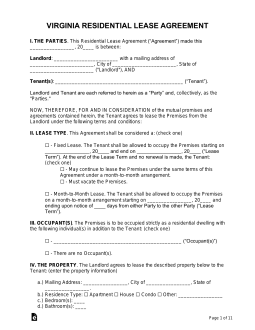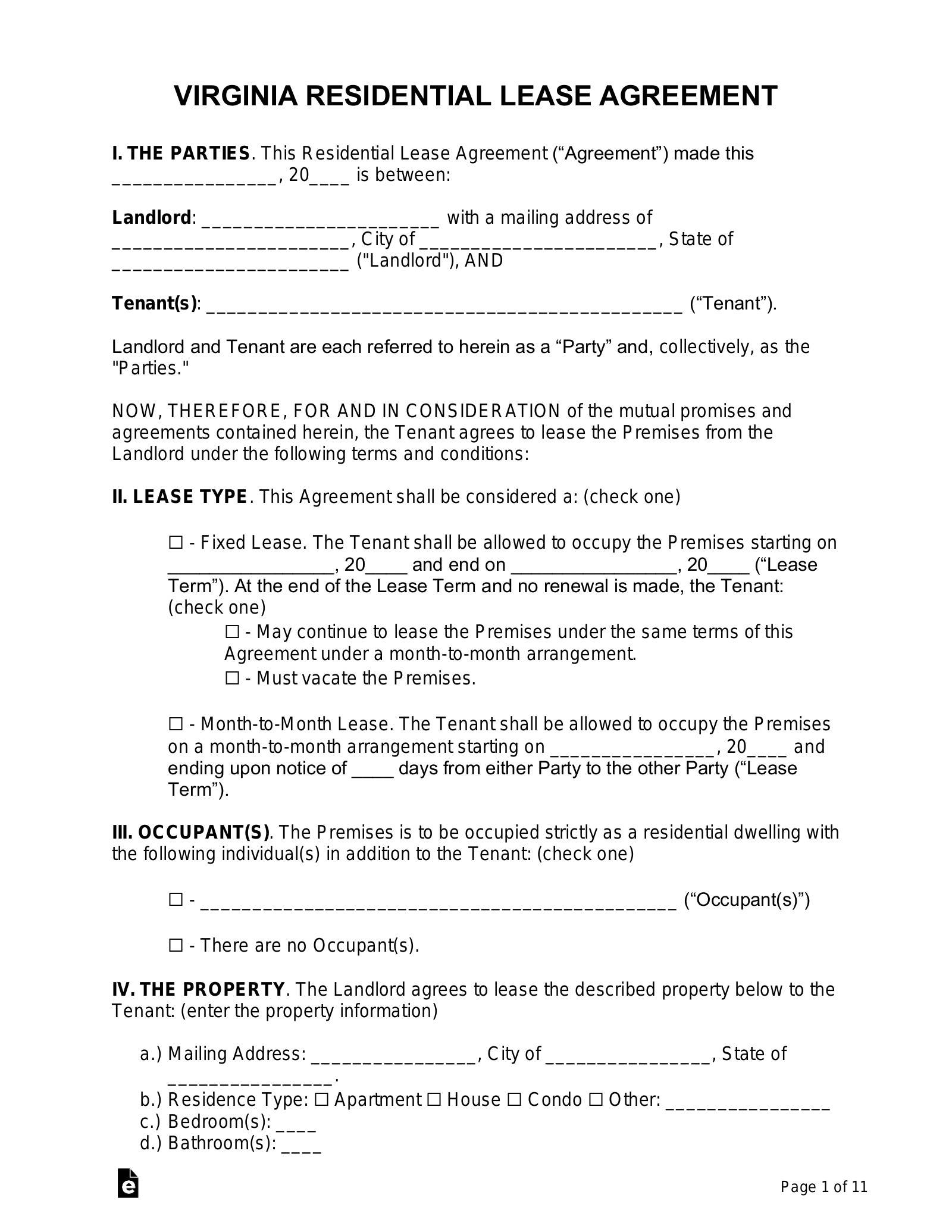Updated March 08, 2024
A Virginia lease agreement is a legally binding contract between a landlord and a tenant for the rental of property for a set period of time. A lease should generally specify the parties involved, the premises being rented, and the amount of money to be paid in rent over the course of the term.
Table of Contents |
Agreement Types (6)
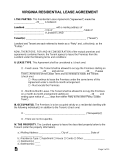 Standard Residential Lease Agreement – For a common landlord-tenant arrangement with a fixed start and end period. The most popular type of residential lease. Standard Residential Lease Agreement – For a common landlord-tenant arrangement with a fixed start and end period. The most popular type of residential lease.
Download: PDF, MS Word, OpenDocument |
 Commercial Lease Agreement – For landlords when authorizing a business-related tenant to their property to operate a professional, retail, or industrial type of use. Commercial Lease Agreement – For landlords when authorizing a business-related tenant to their property to operate a professional, retail, or industrial type of use.
Download: PDF, MS Word, OpenDocument |
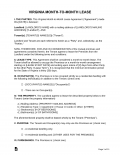 Month-to-Month Lease Agreement – Has no end date which allows either the landlord or tenant to terminate the document with 30 days’ notice. Month-to-Month Lease Agreement – Has no end date which allows either the landlord or tenant to terminate the document with 30 days’ notice.
Download: PDF, MS Word, OpenDocument |
 Rent-to-Own Lease Agreement – Residential rental template with added language for the purchase of the property. Rent-to-Own Lease Agreement – Residential rental template with added language for the purchase of the property.
Download: PDF, MS Word, OpenDocument |
 Room Rental (Roommate) Agreement – Contract written between the members of a home that is shared with each party getting a bedroom. The form coordinates the chores and which individuals will be responsible for expenses. Room Rental (Roommate) Agreement – Contract written between the members of a home that is shared with each party getting a bedroom. The form coordinates the chores and which individuals will be responsible for expenses.
Download: PDF |
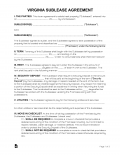 Sublease Agreement – The act of a tenant choosing someone else to use their rented space while they are under agreement with the landlord. This type of tenancy is usually required to be approved by the landlord. Sublease Agreement – The act of a tenant choosing someone else to use their rented space while they are under agreement with the landlord. This type of tenancy is usually required to be approved by the landlord.
Download: PDF |
Required Disclosures (8)
- Defective Drywall (conditional) – If the landlord is aware of defective drywall on the premises, they must disclose this information to the tenant.[1]
- Lead-Based Paint Disclosure – Federal law requires that the landlord of a residence built prior to 1978 must inform any prospective tenants of the possible existence of lead paint in the undercoating of the walls and ceiling.
- Methamphetamines Disclosure (conditional) – If the landlord is aware that the property was previously used to produce methamphetamines and was not cleaned in accordance with the law, they must disclose this to the tenant.[2]
- Military (Air) Zone Disclosure (conditional) – If the property is located in the same area as a military air installation and is in a noise or accident zone, as defined by local zoning maps, the landlord must disclose this to the tenant.[3]
- Move-in Checklist – The landlord must provide the tenant with a written report itemizing any damages to the unit within five days of the beginning of tenancy.[4]
- Mold – As part of the required move-in checklist, the landlord must disclose whether there is visible evidence of mold in the residential unit.[5]
- Electronic Notices (conditional) – If the landlord wishes to send notices to the tenant in electronic form, this must be stated in the lease agreement, and the tenant must be given the right to request notices in paper form.[6]
- Ratio Utility Billing (conditional) – If the landlord uses submetering equipment or a ratio utility billing system in a residential building, this must be stated in the lease agreement.[7]
Security Deposits
Maximum Amount – The landlord cannot charge more than the amount of two months’ rent for a security deposit.[8]
Collecting Interest – Virginia state law does not require that landlords collect or pay interest on a security deposit.
Returning – The landlord must return the security deposit to the tenant within 45 days of the termination date on the lease or the date that the tenant vacates the unit, whichever occurs later.[8]
- Itemized List – If the landlord withholds any portion of the deposit to cover unpaid rent or the costs of damages, these withheld amounts must be itemized in a written notice given to the tenant within 45 days of the end of tenancy.[8]
When is Rent Due?
Grace Period – Virginia statute establishes a five-day grace period for the late payment of rent.[9] If rent is not paid after this grace period, the landlord can send the tenant a five-day notice to quit the property or pay the rent.[10]
Maximum Late Fee – The landlord cannot charge a late fee greater than 10% of the monthly rent or 10% of the unpaid balance.[11]
NSF Fee – $50 is the maximum amount that a landlord can charge a tenant for a bad check.[12]
Withholding Rent – If the landlord, after receiving notice, has failed to remedy an issue in the unit in violation of the lease agreement or the law, the tenant may repair the issue and be reimbursed for up to $1500 or one month’s rent, whichever is greater.[13]
Right to Enter (Landlord)
Standard Access – The landlord must give 72 hours’ notice before entering the residence to perform routine maintenance or other ordinary services.[14]
Immediate Access – The landlord may enter the property without giving notice to the tenant during an emergency or if the landlord is performing maintenance work requested by the tenant.[14]
Abandonment
Absence – A lease agreement may require that the tenant give notice to the landlord in advance of an anticipated absence of more than seven days or be liable for actual damages.[15]
Breaking the Lease – The tenant may end the lease without penalty if the landlord has breached the terms of the lease,[16] the tenant must relocate due to their military service,[17] or the tenant is a victim of family abuse, sexual abuse, or sexual assault.[18]
Tenant’s Utility Shutoff – If the tenant violates the lease agreement or the law by failing to maintain utilities on the property, the landlord may serve a 30-day notice to quit stating that the tenant must remedy the violation within 21 days or vacate the unit.[19]
Unclaimed Property – Any personal property left behind by the tenant after the termination of tenancy may be disposed of by the landlord 24 hours after termination, provided the landlord has given a termination notice to the tenant.[20]

